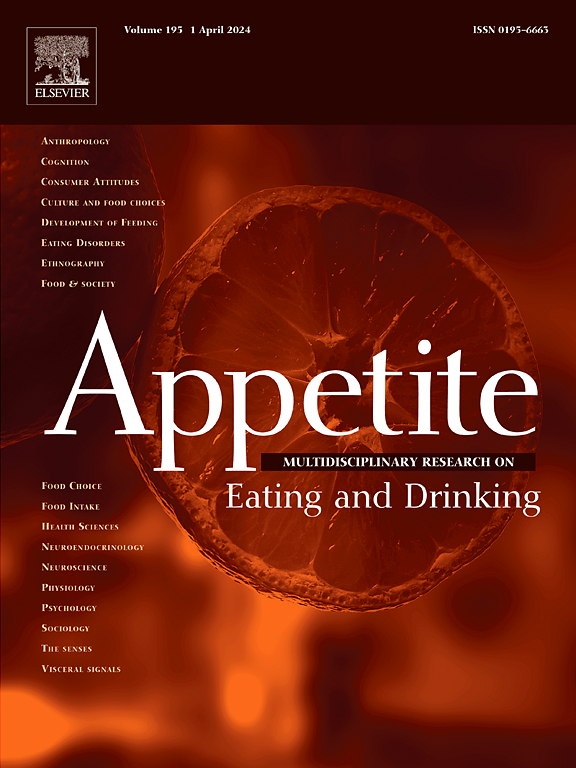限制性喂养(而非工具性喂养)与幼儿无饥饿感进食有关:一项基于实验室的横断面研究。
IF 4.6
2区 医学
Q1 BEHAVIORAL SCIENCES
引用次数: 0
摘要
了解无饥饿感进食(EAH)的早期起源至关重要,因为不适应性食欲调节会导致儿童期体重增加过多。这项横断面研究主要调查了幼儿无饥饿感进食(EAH)与父母喂养方式(PFP)之间的关系,重点是工具性喂养。研究还探讨了与儿童气质或食物可获得性之间的关系,以及它们对 EAH 和 PFP 之间关系的潜在调节作用。66 名父母和 24-36 个月大的幼儿参加了研究。EAH(千卡)采用费舍尔和伯奇(1999 年)的实验室范式进行评估。PFP、儿童的一般气质和食欲特征以及食物的可获得性由家长报告。对儿童的体重和身高进行测量,以计算他们的体重指数 z 分数。线性回归分析了EAH与PFP之间的关系,并对儿童或家长的特征进行了调整或未进行调整。交互作用评估了气质或食物可获得性的调节作用。幼儿的EAH(43±41千卡)与工具性喂养(即用食物作为奖励(r=-0.08,P=0.76)和调节情绪(r=0.04,P=0.76))无关,家长很少使用工具性喂养。EAH与儿童的性情或食物的可获得性无关,但探索性分析表明,EAH与父母出于健康原因的限制(RFH,r=0.30,p=0.01)呈正相关,尤其是在高水平和中等水平的食物易获得性时(RFH x 食物易获得性交互作用:β=12.2,p=0.01)。安抚性并不能调节 EAH 和 PFP 之间的关系。总之,幼儿 EAH 与工具性喂养无关,但与健康相关限制呈正相关。这与食物的可获得性有调节作用,表明在幼儿期限制食物的可获得性可能会缓解这种不利关系。本研究已预先注册(https://osf.io/6r5m8)并获得伦理批准(CEEI,注册号 23-1001)。本文章由计算机程序翻译,如有差异,请以英文原文为准。
Restrictive, but not instrumental feeding, is associated with Eating in the Absence of Hunger in toddlers: A cross-sectional lab-based study
Understanding the early origins of Eating in the Absence of Hunger (EAH) is crucial, as maladaptive appetite regulation contributes to excessive weight gain in childhood. This cross-sectional study primarily investigated in toddlers the associations between EAH and parental feeding practices (PFP), focusing on instrumental feeding. It also explored the associations with children's temperament or food accessibility, and their potential moderating effects on the relationship between EAH and PFP. Sixty-six parents and toddlers aged 24–36 months participated. EAH (kcal) was assessed using Fisher and Birch's (1999) lab-based paradigm. PFP, children's general temperament and appetitive traits, and food accessibility were parent-reported. Children's weight and height were measured to calculate their BMI z-score. Linear regressions analyzed associations between EAH and PFP, adjusted or not for children's or parents' characteristics. Interactions assessed the moderating effects of temperament or food accessibility. Toddlers' EAH (43 ± 41 kcal) was unrelated to instrumental feeding, namely using food as a reward (r = −0.08, p = 0.76) and to regulate emotions (r = 0.04, p = 0.76), which were rarely applied by parents. EAH was not associated with children's temperament or food accessibility, but exploratory analyses revealed a positive association with parental restriction for health reasons (RFH, r = 0.30, p = 0.01), especially at high and moderate levels of Ease of access to food (RFH x Ease of access interaction: β = 12.2, p = 0.01). Soothability did not moderate the relationship between EAH and PFP. In conclusion, toddler's EAH was not associated with instrumental feeding but correlated positively with health-related restriction. This was moderated by food accessibility, suggesting that limiting food accessibility in early childhood may mitigate this adverse relationship. This study was preregistered (https://osf.io/6r5m8) and received ethical approbation (CEEI, registration number 23–1001).
求助全文
通过发布文献求助,成功后即可免费获取论文全文。
去求助
来源期刊

Appetite
医学-行为科学
CiteScore
9.10
自引率
11.10%
发文量
566
审稿时长
13.4 weeks
期刊介绍:
Appetite is an international research journal specializing in cultural, social, psychological, sensory and physiological influences on the selection and intake of foods and drinks. It covers normal and disordered eating and drinking and welcomes studies of both human and non-human animal behaviour toward food. Appetite publishes research reports, reviews and commentaries. Thematic special issues appear regularly. From time to time the journal carries abstracts from professional meetings. Submissions to Appetite are expected to be based primarily on observations directly related to the selection and intake of foods and drinks; papers that are primarily focused on topics such as nutrition or obesity will not be considered unless they specifically make a novel scientific contribution to the understanding of appetite in line with the journal's aims and scope.
 求助内容:
求助内容: 应助结果提醒方式:
应助结果提醒方式:


